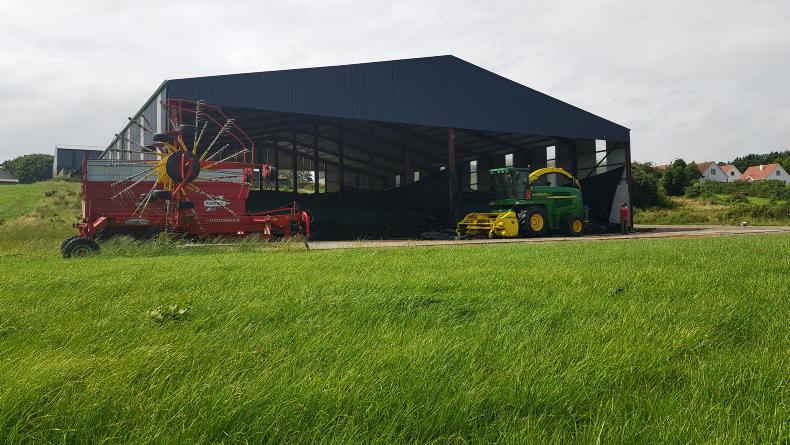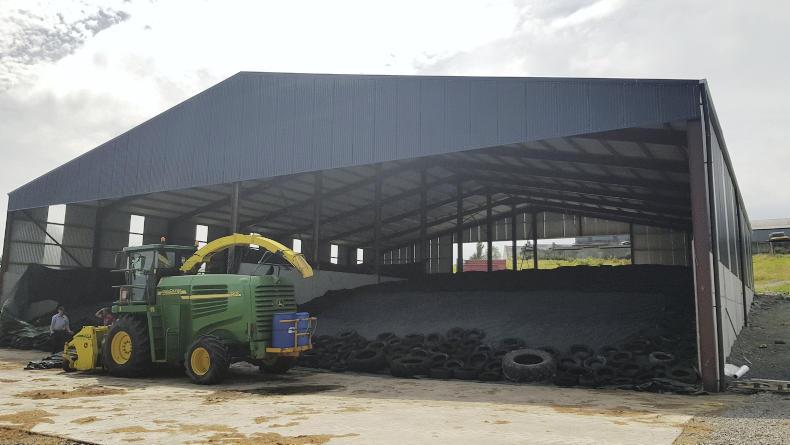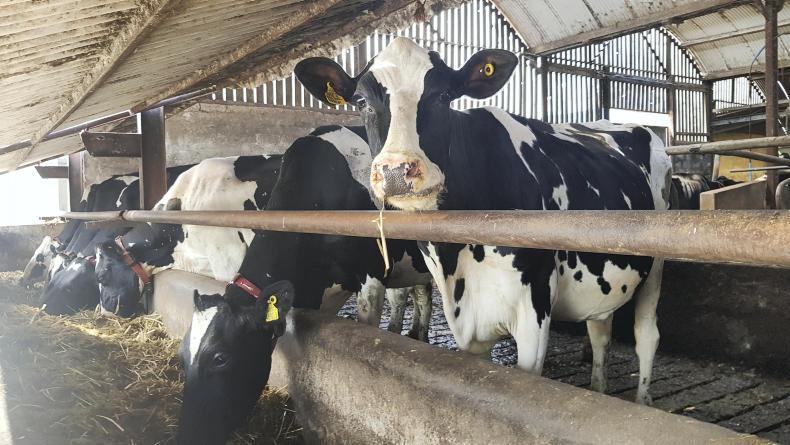Mastitis appears to be well under control on the Martin farm in Dromintee, Co Armagh.
James and his father Owen looked through veterinary records last week and found that there had been 20 cases of mastitis in the 150-cow herd over the past 12 months, with seven of these being repeat cases.
Somatic cell count usually sits around 150,000-160,000/ml at Garaba Holsteins.
James said that somatic cell count and mastitis incidence dropped in the herd when a cluster wash system was added to the milking routine in 2013.
This was a manual system were cups were sprayed with peracetic acid between individual cows during milking. James said it added around 20 minutes to milking time.

The Martins, with help from some locals, cut, rake and lift all their grass silage themselves.
However, a new milking parlour was constructed on the Martin farm in 2015 which included an automatic cluster wash system.
The plumbed-in system forces the disinfectant through the cluster after each cow. It has proved just as effective at controlling the spread of infection and is less time-consuming.
The Martins operate a fully housed, year-round calving system. In the cow house, cubicles are currently bedded with sawdust, although James is planning on changing to a mixture of lime, straw and water.
He saw this on a CAFRE study visit to dairy farms in the Netherlands earlier this year.
There is no pre-dipping carried out and all cows get a post-milking iodine spray
It will involve chopping straw in the forage harvester and then mixing 0.6t of chopped straw, one tonne of lime and 0.5t of water in the diet feeder.
Cows are milked in a 24-unit swing over the parlour. Milking routine involves wiping teats, stripping out all quarters and attaching cups on eight cows at a time.
There is no pre-dipping carried out and all cows get a post-milking iodine spray.
The Martins have a flat supply profile, with cows currently yielding 30l/cow/day at 3.70% fat and 3.09% protein.

The Martins, with help from some locals, cut, rake and lift all their grass silage themselves.
The high-yielding group is on total mixed ration (TMR) of 10kg/cow/day of blend, plus silage and straw. Low-yielders are on the same blend, but at a lower rate of 6kg/cow/day.
Cows have EID tags which are compatible with both the in-parlour feed-to-yield system and an automatic drafting gate for dividing cows on the way back to the cubicle house.
The high-yielding group receives a maximum feed rate of 7kg/cow/day in the parlour, with feeders set for the TMR delivering maintenance plus 28l.
When a cow calves, she is kept in the straw-bedded calving pen for two or three days and fed from the low-yielders ration
Low-yielders get up to 1kg/cow/day in the parlour, with the TMR giving maintenance plus 20l.
When a cow calves, she is kept in the straw-bedded calving pen for two or three days and fed from the low-yielders ration.
Freshly calved cows are then put into the low-yielders pen for a week before going into the high-yielding group. Meal is gradually built up in the parlour at 0.4kg/day to a feed rate based on milk yield.
There is a third in-parlour feeder group for heifers, which builds up slightly quicker after calving and has a maximum daily allocation of 5.5kg/cow/day.
Read more
Dairylink: making silage four times a year
Dairylink: expanding on a fragmented land block
Mastitis appears to be well under control on the Martin farm in Dromintee, Co Armagh.
James and his father Owen looked through veterinary records last week and found that there had been 20 cases of mastitis in the 150-cow herd over the past 12 months, with seven of these being repeat cases.
Somatic cell count usually sits around 150,000-160,000/ml at Garaba Holsteins.
James said that somatic cell count and mastitis incidence dropped in the herd when a cluster wash system was added to the milking routine in 2013.
This was a manual system were cups were sprayed with peracetic acid between individual cows during milking. James said it added around 20 minutes to milking time.

The Martins, with help from some locals, cut, rake and lift all their grass silage themselves.
However, a new milking parlour was constructed on the Martin farm in 2015 which included an automatic cluster wash system.
The plumbed-in system forces the disinfectant through the cluster after each cow. It has proved just as effective at controlling the spread of infection and is less time-consuming.
The Martins operate a fully housed, year-round calving system. In the cow house, cubicles are currently bedded with sawdust, although James is planning on changing to a mixture of lime, straw and water.
He saw this on a CAFRE study visit to dairy farms in the Netherlands earlier this year.
There is no pre-dipping carried out and all cows get a post-milking iodine spray
It will involve chopping straw in the forage harvester and then mixing 0.6t of chopped straw, one tonne of lime and 0.5t of water in the diet feeder.
Cows are milked in a 24-unit swing over the parlour. Milking routine involves wiping teats, stripping out all quarters and attaching cups on eight cows at a time.
There is no pre-dipping carried out and all cows get a post-milking iodine spray.
The Martins have a flat supply profile, with cows currently yielding 30l/cow/day at 3.70% fat and 3.09% protein.

The Martins, with help from some locals, cut, rake and lift all their grass silage themselves.
The high-yielding group is on total mixed ration (TMR) of 10kg/cow/day of blend, plus silage and straw. Low-yielders are on the same blend, but at a lower rate of 6kg/cow/day.
Cows have EID tags which are compatible with both the in-parlour feed-to-yield system and an automatic drafting gate for dividing cows on the way back to the cubicle house.
The high-yielding group receives a maximum feed rate of 7kg/cow/day in the parlour, with feeders set for the TMR delivering maintenance plus 28l.
When a cow calves, she is kept in the straw-bedded calving pen for two or three days and fed from the low-yielders ration
Low-yielders get up to 1kg/cow/day in the parlour, with the TMR giving maintenance plus 20l.
When a cow calves, she is kept in the straw-bedded calving pen for two or three days and fed from the low-yielders ration.
Freshly calved cows are then put into the low-yielders pen for a week before going into the high-yielding group. Meal is gradually built up in the parlour at 0.4kg/day to a feed rate based on milk yield.
There is a third in-parlour feeder group for heifers, which builds up slightly quicker after calving and has a maximum daily allocation of 5.5kg/cow/day.
Read more
Dairylink: making silage four times a year
Dairylink: expanding on a fragmented land block








 This is a subscriber-only article
This is a subscriber-only article










SHARING OPTIONS: